Business and Business Environment: Unit 1 Report - GBS200576 Analysis
VerifiedAdded on 2021/09/02
|14
|3947
|72
Report
AI Summary
This report provides a comprehensive analysis of the business and business environment, covering various organizational structures and types, including for-profit, non-profit, and non-governmental organizations (NGOs). It differentiates between organizations based on size and scope, examining the implications of these differences on business objectives and the supply of goods and services. The report delves into the range of legal structures associated with different forms of business, such as sole traders, partnerships, and private limited companies, and analyzes the global growth and development of transnational, international, and global organizations. Furthermore, it applies Porter's five forces to the fashion retail industry, providing a practical application of business analysis concepts. This report is a valuable resource for students studying business and related fields, offering insights into key aspects of the business environment.
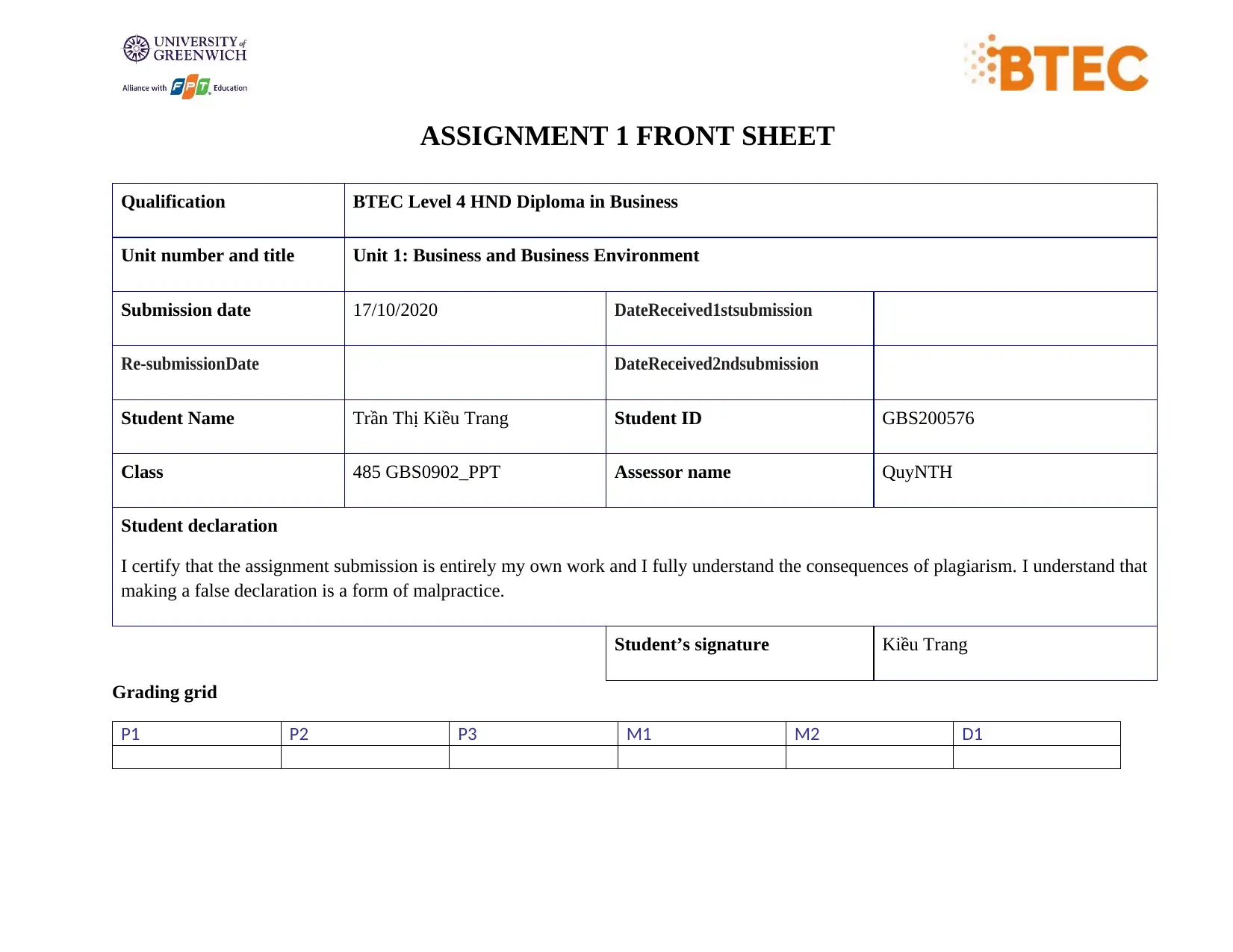
ASSIGNMENT 1 FRONT SHEET
Qualification BTEC Level 4 HND Diploma in Business
Unit number and title Unit 1: Business and Business Environment
Submission date 17/10/2020 DateReceived1stsubmission
Re-submissionDate DateReceived2ndsubmission
Student Name Trần Thị Kiều Trang Student ID GBS200576
Class 485 GBS0902_PPT Assessor name QuyNTH
Student declaration
I certify that the assignment submission is entirely my own work and I fully understand the consequences of plagiarism. I understand that
making a false declaration is a form of malpractice.
Student’s signature Kiều Trang
Grading grid
P1 P2 P3 M1 M2 D1
Qualification BTEC Level 4 HND Diploma in Business
Unit number and title Unit 1: Business and Business Environment
Submission date 17/10/2020 DateReceived1stsubmission
Re-submissionDate DateReceived2ndsubmission
Student Name Trần Thị Kiều Trang Student ID GBS200576
Class 485 GBS0902_PPT Assessor name QuyNTH
Student declaration
I certify that the assignment submission is entirely my own work and I fully understand the consequences of plagiarism. I understand that
making a false declaration is a form of malpractice.
Student’s signature Kiều Trang
Grading grid
P1 P2 P3 M1 M2 D1
Paraphrase This Document
Need a fresh take? Get an instant paraphrase of this document with our AI Paraphraser
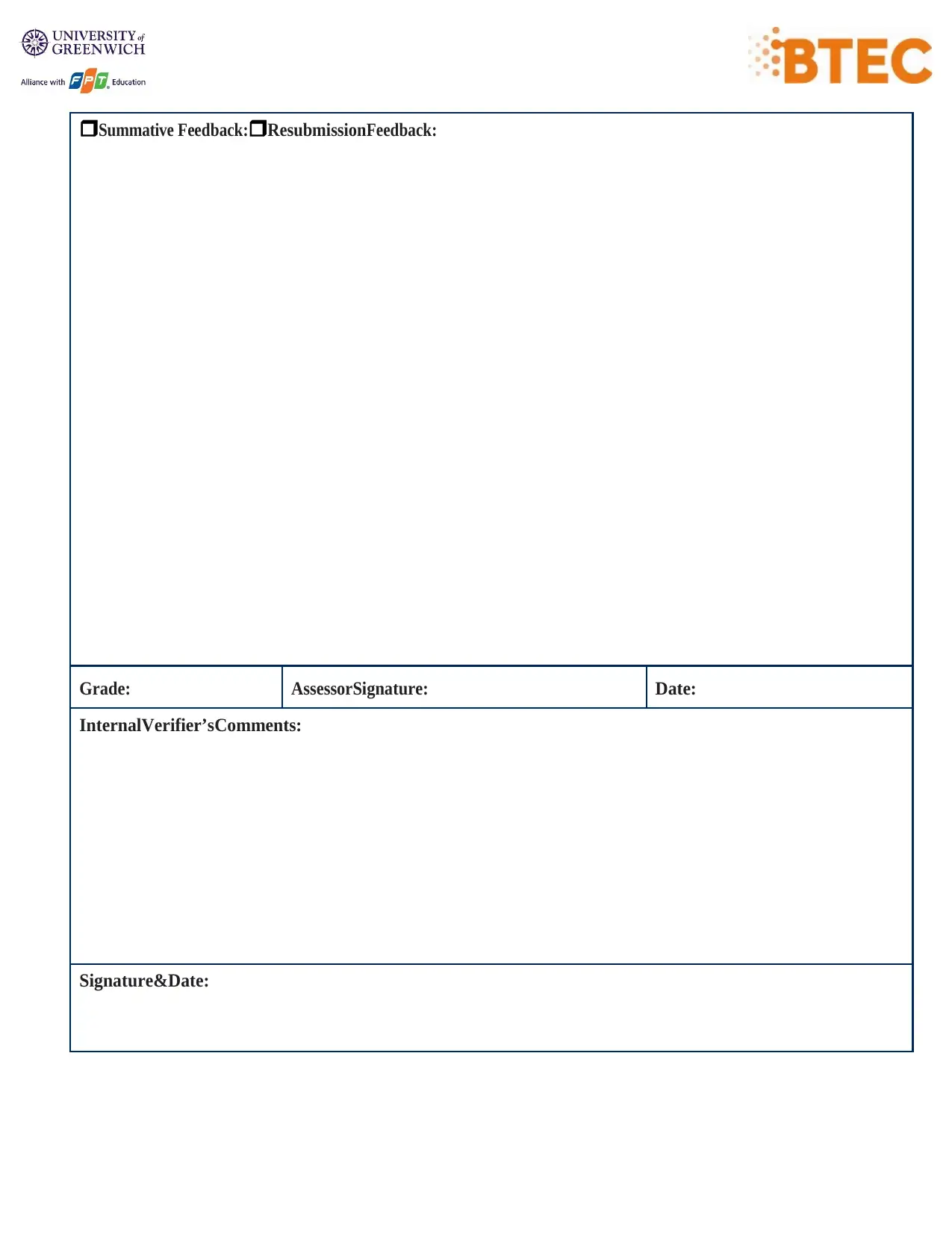
Summative Feedback: Resubmission Feedback:
Grade: AssessorSignature: Date:
InternalVerifier’sComments:
Signature&Date:
Grade: AssessorSignature: Date:
InternalVerifier’sComments:
Signature&Date:
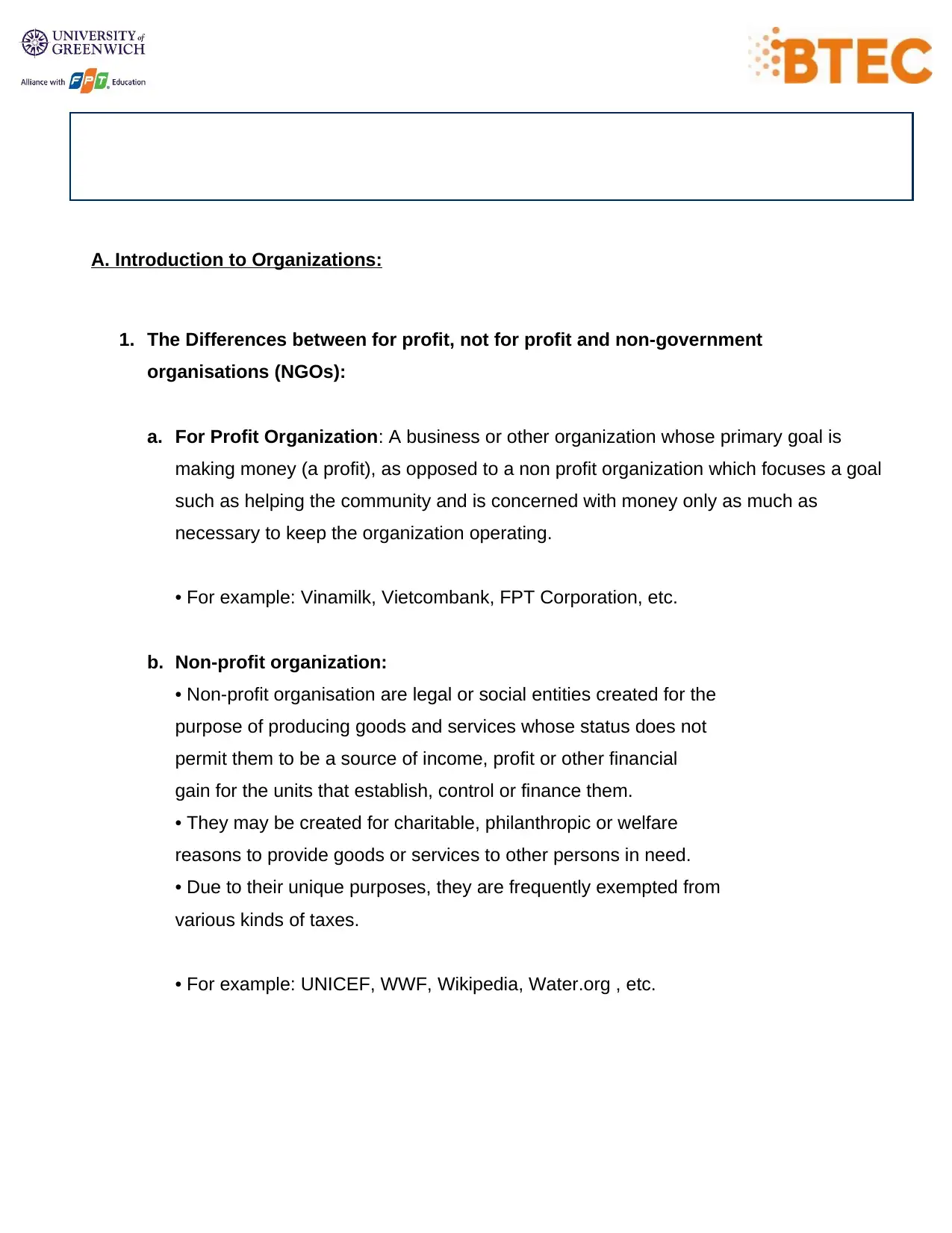
A. Introduction to Organizations:
1. The Differences between for profit, not for profit and non-government
organisations (NGOs):
a. For Profit Organization: A business or other organization whose primary goal is
making money (a profit), as opposed to a non profit organization which focuses a goal
such as helping the community and is concerned with money only as much as
necessary to keep the organization operating.
• For example: Vinamilk, Vietcombank, FPT Corporation, etc.
b. Non-profit organization:
• Non-profit organisation are legal or social entities created for the
purpose of producing goods and services whose status does not
permit them to be a source of income, profit or other financial
gain for the units that establish, control or finance them.
• They may be created for charitable, philanthropic or welfare
reasons to provide goods or services to other persons in need.
• Due to their unique purposes, they are frequently exempted from
various kinds of taxes.
• For example: UNICEF, WWF, Wikipedia, Water.org , etc.
1. The Differences between for profit, not for profit and non-government
organisations (NGOs):
a. For Profit Organization: A business or other organization whose primary goal is
making money (a profit), as opposed to a non profit organization which focuses a goal
such as helping the community and is concerned with money only as much as
necessary to keep the organization operating.
• For example: Vinamilk, Vietcombank, FPT Corporation, etc.
b. Non-profit organization:
• Non-profit organisation are legal or social entities created for the
purpose of producing goods and services whose status does not
permit them to be a source of income, profit or other financial
gain for the units that establish, control or finance them.
• They may be created for charitable, philanthropic or welfare
reasons to provide goods or services to other persons in need.
• Due to their unique purposes, they are frequently exempted from
various kinds of taxes.
• For example: UNICEF, WWF, Wikipedia, Water.org , etc.
⊘ This is a preview!⊘
Do you want full access?
Subscribe today to unlock all pages.

Trusted by 1+ million students worldwide
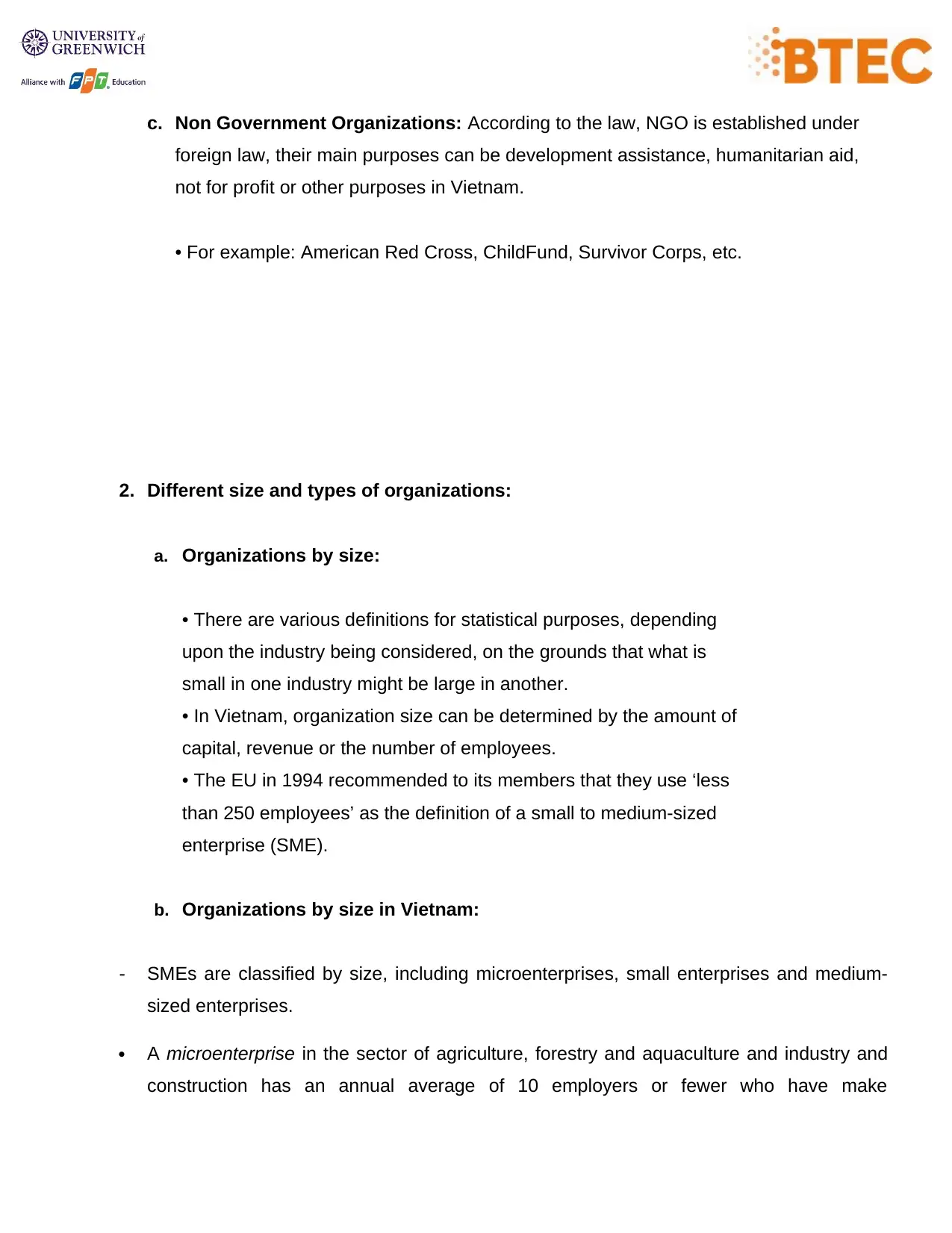
c. Non Government Organizations: According to the law, NGO is established under
foreign law, their main purposes can be development assistance, humanitarian aid,
not for profit or other purposes in Vietnam.
• For example: American Red Cross, ChildFund, Survivor Corps, etc.
2. Different size and types of organizations:
a. Organizations by size:
• There are various definitions for statistical purposes, depending
upon the industry being considered, on the grounds that what is
small in one industry might be large in another.
• In Vietnam, organization size can be determined by the amount of
capital, revenue or the number of employees.
• The EU in 1994 recommended to its members that they use ‘less
than 250 employees’ as the definition of a small to medium-sized
enterprise (SME).
b. Organizations by size in Vietnam:
- SMEs are classified by size, including microenterprises, small enterprises and medium-
sized enterprises.
A microenterprise in the sector of agriculture, forestry and aquaculture and industry and
construction has an annual average of 10 employers or fewer who have make
foreign law, their main purposes can be development assistance, humanitarian aid,
not for profit or other purposes in Vietnam.
• For example: American Red Cross, ChildFund, Survivor Corps, etc.
2. Different size and types of organizations:
a. Organizations by size:
• There are various definitions for statistical purposes, depending
upon the industry being considered, on the grounds that what is
small in one industry might be large in another.
• In Vietnam, organization size can be determined by the amount of
capital, revenue or the number of employees.
• The EU in 1994 recommended to its members that they use ‘less
than 250 employees’ as the definition of a small to medium-sized
enterprise (SME).
b. Organizations by size in Vietnam:
- SMEs are classified by size, including microenterprises, small enterprises and medium-
sized enterprises.
A microenterprise in the sector of agriculture, forestry and aquaculture and industry and
construction has an annual average of 10 employers or fewer who have make
Paraphrase This Document
Need a fresh take? Get an instant paraphrase of this document with our AI Paraphraser
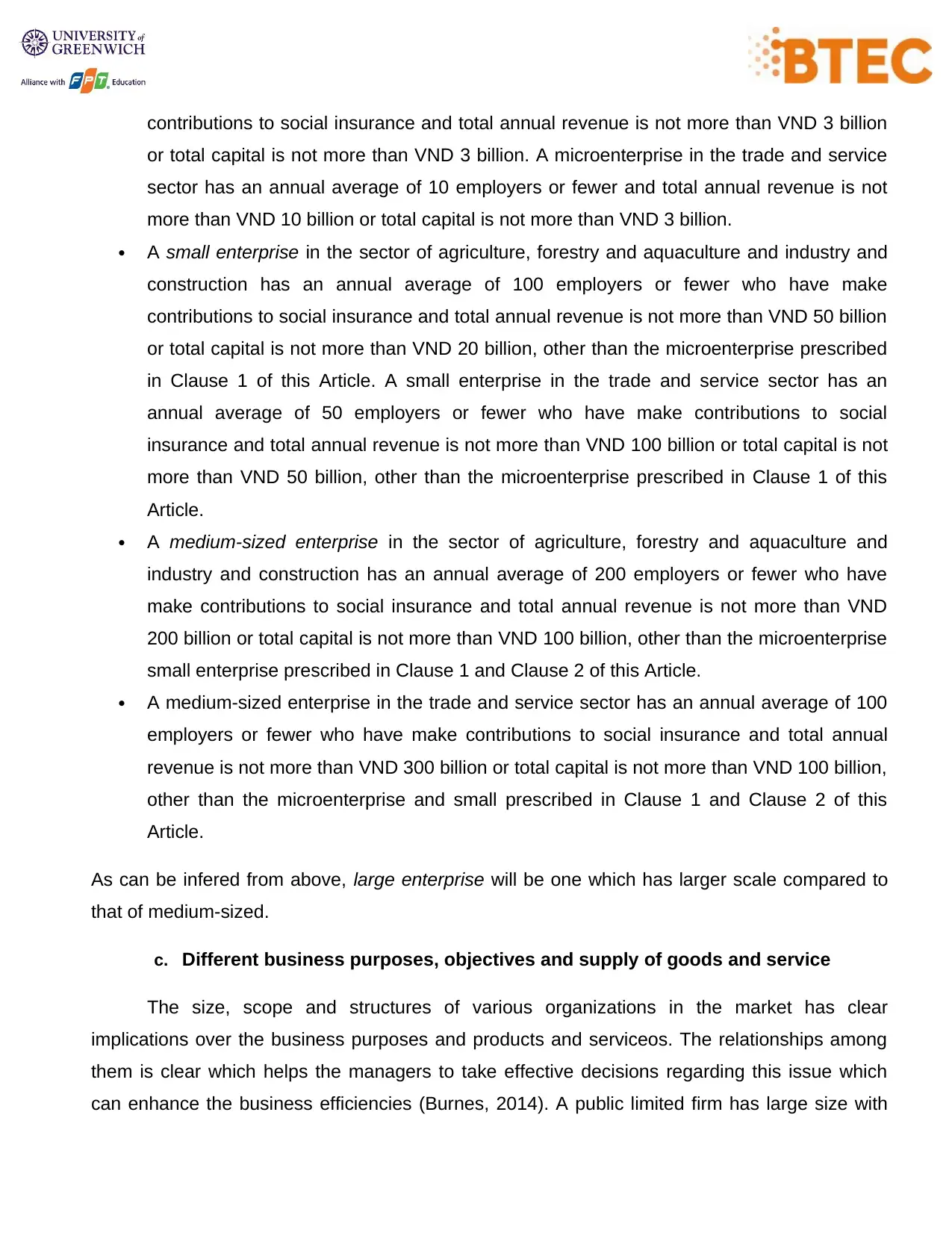
contributions to social insurance and total annual revenue is not more than VND 3 billion
or total capital is not more than VND 3 billion. A microenterprise in the trade and service
sector has an annual average of 10 employers or fewer and total annual revenue is not
more than VND 10 billion or total capital is not more than VND 3 billion.
A small enterprise in the sector of agriculture, forestry and aquaculture and industry and
construction has an annual average of 100 employers or fewer who have make
contributions to social insurance and total annual revenue is not more than VND 50 billion
or total capital is not more than VND 20 billion, other than the microenterprise prescribed
in Clause 1 of this Article. A small enterprise in the trade and service sector has an
annual average of 50 employers or fewer who have make contributions to social
insurance and total annual revenue is not more than VND 100 billion or total capital is not
more than VND 50 billion, other than the microenterprise prescribed in Clause 1 of this
Article.
A medium-sized enterprise in the sector of agriculture, forestry and aquaculture and
industry and construction has an annual average of 200 employers or fewer who have
make contributions to social insurance and total annual revenue is not more than VND
200 billion or total capital is not more than VND 100 billion, other than the microenterprise
small enterprise prescribed in Clause 1 and Clause 2 of this Article.
A medium-sized enterprise in the trade and service sector has an annual average of 100
employers or fewer who have make contributions to social insurance and total annual
revenue is not more than VND 300 billion or total capital is not more than VND 100 billion,
other than the microenterprise and small prescribed in Clause 1 and Clause 2 of this
Article.
As can be infered from above, large enterprise will be one which has larger scale compared to
that of medium-sized.
c. Different business purposes, objectives and supply of goods and service
The size, scope and structures of various organizations in the market has clear
implications over the business purposes and products and serviceos. The relationships among
them is clear which helps the managers to take effective decisions regarding this issue which
can enhance the business efficiencies (Burnes, 2014). A public limited firm has large size with
or total capital is not more than VND 3 billion. A microenterprise in the trade and service
sector has an annual average of 10 employers or fewer and total annual revenue is not
more than VND 10 billion or total capital is not more than VND 3 billion.
A small enterprise in the sector of agriculture, forestry and aquaculture and industry and
construction has an annual average of 100 employers or fewer who have make
contributions to social insurance and total annual revenue is not more than VND 50 billion
or total capital is not more than VND 20 billion, other than the microenterprise prescribed
in Clause 1 of this Article. A small enterprise in the trade and service sector has an
annual average of 50 employers or fewer who have make contributions to social
insurance and total annual revenue is not more than VND 100 billion or total capital is not
more than VND 50 billion, other than the microenterprise prescribed in Clause 1 of this
Article.
A medium-sized enterprise in the sector of agriculture, forestry and aquaculture and
industry and construction has an annual average of 200 employers or fewer who have
make contributions to social insurance and total annual revenue is not more than VND
200 billion or total capital is not more than VND 100 billion, other than the microenterprise
small enterprise prescribed in Clause 1 and Clause 2 of this Article.
A medium-sized enterprise in the trade and service sector has an annual average of 100
employers or fewer who have make contributions to social insurance and total annual
revenue is not more than VND 300 billion or total capital is not more than VND 100 billion,
other than the microenterprise and small prescribed in Clause 1 and Clause 2 of this
Article.
As can be infered from above, large enterprise will be one which has larger scale compared to
that of medium-sized.
c. Different business purposes, objectives and supply of goods and service
The size, scope and structures of various organizations in the market has clear
implications over the business purposes and products and serviceos. The relationships among
them is clear which helps the managers to take effective decisions regarding this issue which
can enhance the business efficiencies (Burnes, 2014). A public limited firm has large size with
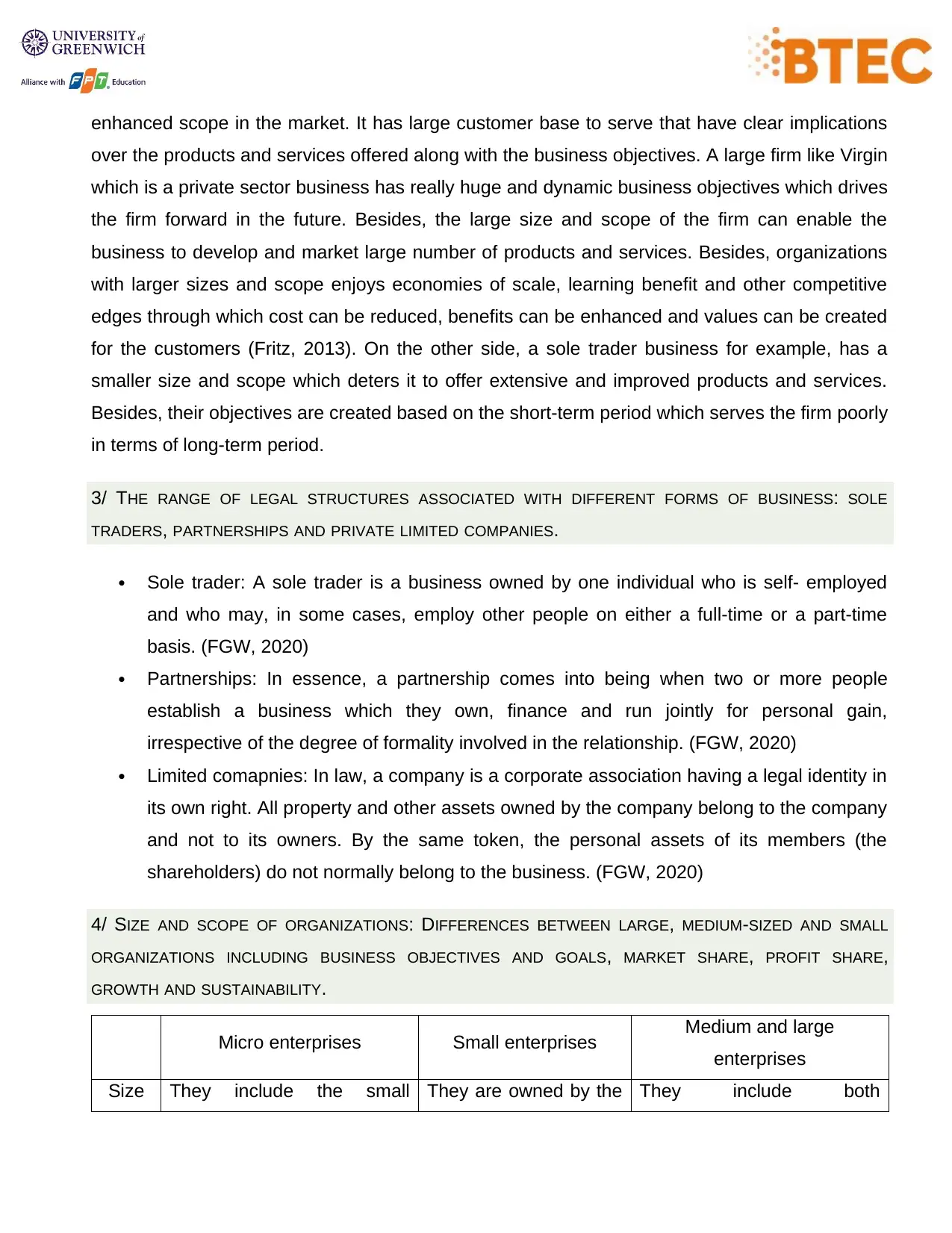
enhanced scope in the market. It has large customer base to serve that have clear implications
over the products and services offered along with the business objectives. A large firm like Virgin
which is a private sector business has really huge and dynamic business objectives which drives
the firm forward in the future. Besides, the large size and scope of the firm can enable the
business to develop and market large number of products and services. Besides, organizations
with larger sizes and scope enjoys economies of scale, learning benefit and other competitive
edges through which cost can be reduced, benefits can be enhanced and values can be created
for the customers (Fritz, 2013). On the other side, a sole trader business for example, has a
smaller size and scope which deters it to offer extensive and improved products and services.
Besides, their objectives are created based on the short-term period which serves the firm poorly
in terms of long-term period.
3/ THE RANGE OF LEGAL STRUCTURES ASSOCIATED WITH DIFFERENT FORMS OF BUSINESS: SOLE
TRADERS, PARTNERSHIPS AND PRIVATE LIMITED COMPANIES.
Sole trader: A sole trader is a business owned by one individual who is self- employed
and who may, in some cases, employ other people on either a full-time or a part-time
basis. (FGW, 2020)
Partnerships: In essence, a partnership comes into being when two or more people
establish a business which they own, finance and run jointly for personal gain,
irrespective of the degree of formality involved in the relationship. (FGW, 2020)
Limited comapnies: In law, a company is a corporate association having a legal identity in
its own right. All property and other assets owned by the company belong to the company
and not to its owners. By the same token, the personal assets of its members (the
shareholders) do not normally belong to the business. (FGW, 2020)
4/ SIZE AND SCOPE OF ORGANIZATIONS: DIFFERENCES BETWEEN LARGE, MEDIUM-SIZED AND SMALL
ORGANIZATIONS INCLUDING BUSINESS OBJECTIVES AND GOALS, MARKET SHARE, PROFIT SHARE,
GROWTH AND SUSTAINABILITY.
Micro enterprises Small enterprises Medium and large
enterprises
Size They include the small They are owned by the They include both
over the products and services offered along with the business objectives. A large firm like Virgin
which is a private sector business has really huge and dynamic business objectives which drives
the firm forward in the future. Besides, the large size and scope of the firm can enable the
business to develop and market large number of products and services. Besides, organizations
with larger sizes and scope enjoys economies of scale, learning benefit and other competitive
edges through which cost can be reduced, benefits can be enhanced and values can be created
for the customers (Fritz, 2013). On the other side, a sole trader business for example, has a
smaller size and scope which deters it to offer extensive and improved products and services.
Besides, their objectives are created based on the short-term period which serves the firm poorly
in terms of long-term period.
3/ THE RANGE OF LEGAL STRUCTURES ASSOCIATED WITH DIFFERENT FORMS OF BUSINESS: SOLE
TRADERS, PARTNERSHIPS AND PRIVATE LIMITED COMPANIES.
Sole trader: A sole trader is a business owned by one individual who is self- employed
and who may, in some cases, employ other people on either a full-time or a part-time
basis. (FGW, 2020)
Partnerships: In essence, a partnership comes into being when two or more people
establish a business which they own, finance and run jointly for personal gain,
irrespective of the degree of formality involved in the relationship. (FGW, 2020)
Limited comapnies: In law, a company is a corporate association having a legal identity in
its own right. All property and other assets owned by the company belong to the company
and not to its owners. By the same token, the personal assets of its members (the
shareholders) do not normally belong to the business. (FGW, 2020)
4/ SIZE AND SCOPE OF ORGANIZATIONS: DIFFERENCES BETWEEN LARGE, MEDIUM-SIZED AND SMALL
ORGANIZATIONS INCLUDING BUSINESS OBJECTIVES AND GOALS, MARKET SHARE, PROFIT SHARE,
GROWTH AND SUSTAINABILITY.
Micro enterprises Small enterprises Medium and large
enterprises
Size They include the small They are owned by the They include both
⊘ This is a preview!⊘
Do you want full access?
Subscribe today to unlock all pages.

Trusted by 1+ million students worldwide
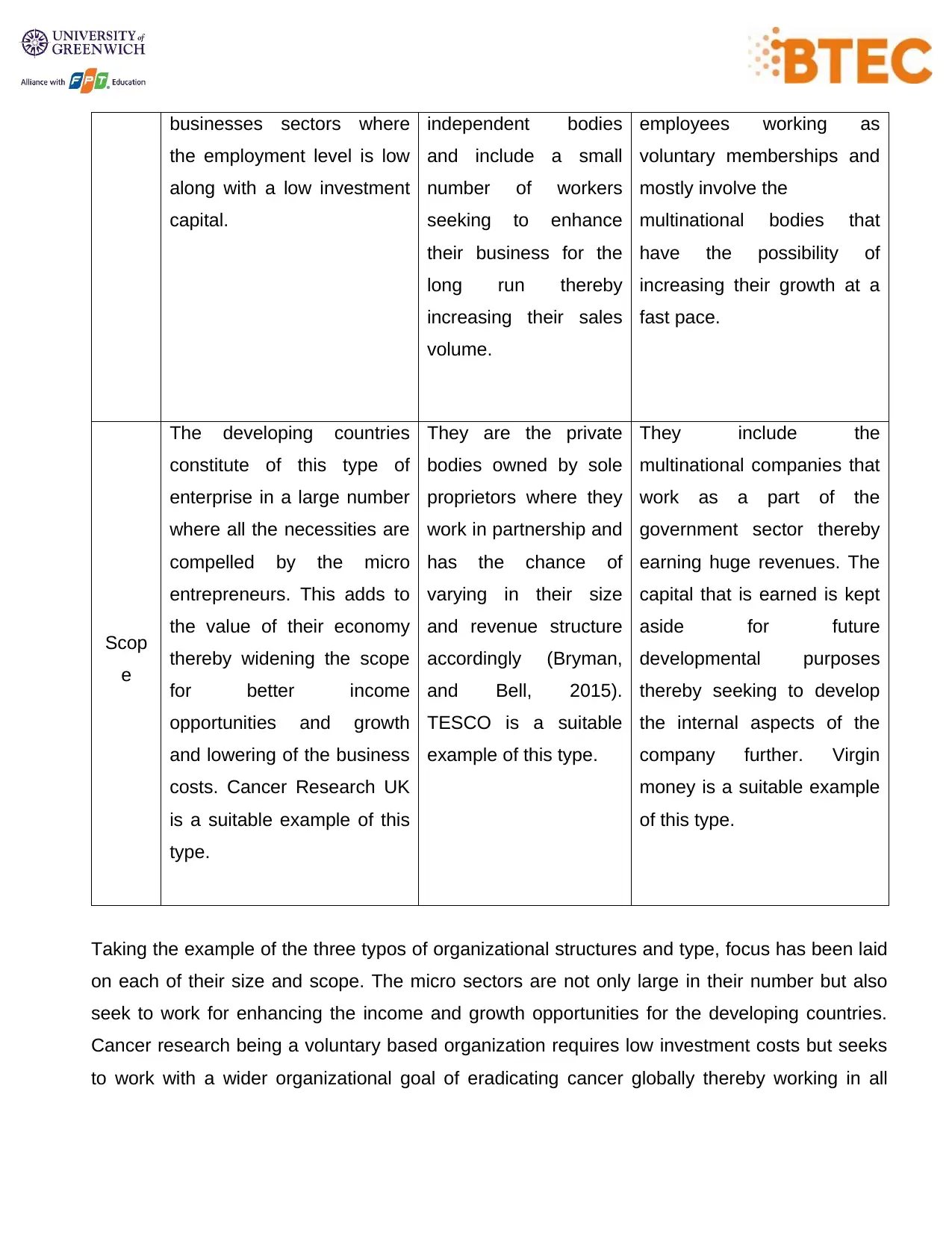
businesses sectors where
the employment level is low
along with a low investment
capital.
independent bodies
and include a small
number of workers
seeking to enhance
their business for the
long run thereby
increasing their sales
volume.
employees working as
voluntary memberships and
mostly involve the
multinational bodies that
have the possibility of
increasing their growth at a
fast pace.
Scop
e
The developing countries
constitute of this type of
enterprise in a large number
where all the necessities are
compelled by the micro
entrepreneurs. This adds to
the value of their economy
thereby widening the scope
for better income
opportunities and growth
and lowering of the business
costs. Cancer Research UK
is a suitable example of this
type.
They are the private
bodies owned by sole
proprietors where they
work in partnership and
has the chance of
varying in their size
and revenue structure
accordingly (Bryman,
and Bell, 2015).
TESCO is a suitable
example of this type.
They include the
multinational companies that
work as a part of the
government sector thereby
earning huge revenues. The
capital that is earned is kept
aside for future
developmental purposes
thereby seeking to develop
the internal aspects of the
company further. Virgin
money is a suitable example
of this type.
Taking the example of the three typos of organizational structures and type, focus has been laid
on each of their size and scope. The micro sectors are not only large in their number but also
seek to work for enhancing the income and growth opportunities for the developing countries.
Cancer research being a voluntary based organization requires low investment costs but seeks
to work with a wider organizational goal of eradicating cancer globally thereby working in all
the employment level is low
along with a low investment
capital.
independent bodies
and include a small
number of workers
seeking to enhance
their business for the
long run thereby
increasing their sales
volume.
employees working as
voluntary memberships and
mostly involve the
multinational bodies that
have the possibility of
increasing their growth at a
fast pace.
Scop
e
The developing countries
constitute of this type of
enterprise in a large number
where all the necessities are
compelled by the micro
entrepreneurs. This adds to
the value of their economy
thereby widening the scope
for better income
opportunities and growth
and lowering of the business
costs. Cancer Research UK
is a suitable example of this
type.
They are the private
bodies owned by sole
proprietors where they
work in partnership and
has the chance of
varying in their size
and revenue structure
accordingly (Bryman,
and Bell, 2015).
TESCO is a suitable
example of this type.
They include the
multinational companies that
work as a part of the
government sector thereby
earning huge revenues. The
capital that is earned is kept
aside for future
developmental purposes
thereby seeking to develop
the internal aspects of the
company further. Virgin
money is a suitable example
of this type.
Taking the example of the three typos of organizational structures and type, focus has been laid
on each of their size and scope. The micro sectors are not only large in their number but also
seek to work for enhancing the income and growth opportunities for the developing countries.
Cancer research being a voluntary based organization requires low investment costs but seeks
to work with a wider organizational goal of eradicating cancer globally thereby working in all
Paraphrase This Document
Need a fresh take? Get an instant paraphrase of this document with our AI Paraphraser
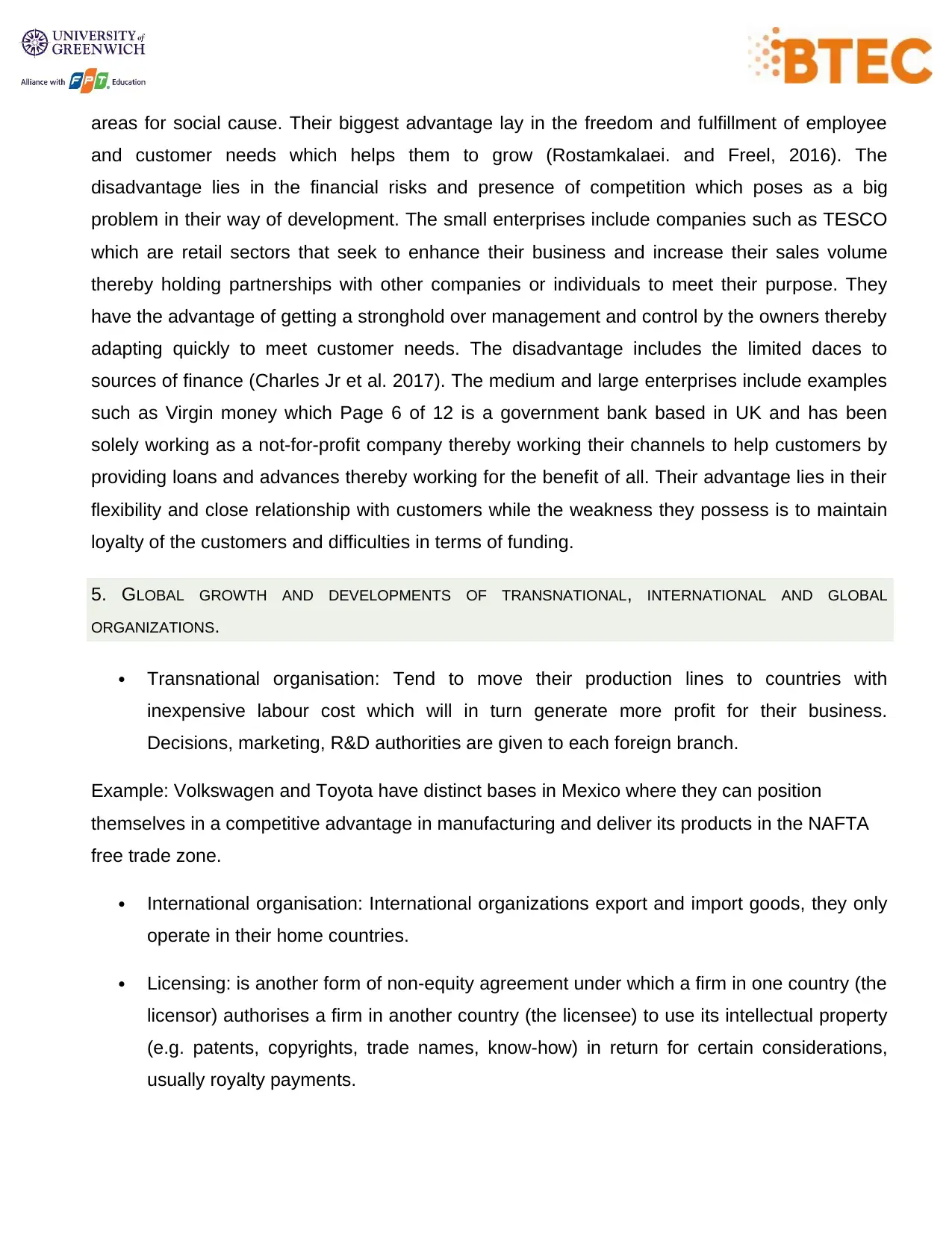
areas for social cause. Their biggest advantage lay in the freedom and fulfillment of employee
and customer needs which helps them to grow (Rostamkalaei. and Freel, 2016). The
disadvantage lies in the financial risks and presence of competition which poses as a big
problem in their way of development. The small enterprises include companies such as TESCO
which are retail sectors that seek to enhance their business and increase their sales volume
thereby holding partnerships with other companies or individuals to meet their purpose. They
have the advantage of getting a stronghold over management and control by the owners thereby
adapting quickly to meet customer needs. The disadvantage includes the limited daces to
sources of finance (Charles Jr et al. 2017). The medium and large enterprises include examples
such as Virgin money which Page 6 of 12 is a government bank based in UK and has been
solely working as a not-for-profit company thereby working their channels to help customers by
providing loans and advances thereby working for the benefit of all. Their advantage lies in their
flexibility and close relationship with customers while the weakness they possess is to maintain
loyalty of the customers and difficulties in terms of funding.
5. GLOBAL GROWTH AND DEVELOPMENTS OF TRANSNATIONAL, INTERNATIONAL AND GLOBAL
ORGANIZATIONS.
Transnational organisation: Tend to move their production lines to countries with
inexpensive labour cost which will in turn generate more profit for their business.
Decisions, marketing, R&D authorities are given to each foreign branch.
Example: Volkswagen and Toyota have distinct bases in Mexico where they can position
themselves in a competitive advantage in manufacturing and deliver its products in the NAFTA
free trade zone.
International organisation: International organizations export and import goods, they only
operate in their home countries.
Licensing: is another form of non-equity agreement under which a firm in one country (the
licensor) authorises a firm in another country (the licensee) to use its intellectual property
(e.g. patents, copyrights, trade names, know-how) in return for certain considerations,
usually royalty payments.
and customer needs which helps them to grow (Rostamkalaei. and Freel, 2016). The
disadvantage lies in the financial risks and presence of competition which poses as a big
problem in their way of development. The small enterprises include companies such as TESCO
which are retail sectors that seek to enhance their business and increase their sales volume
thereby holding partnerships with other companies or individuals to meet their purpose. They
have the advantage of getting a stronghold over management and control by the owners thereby
adapting quickly to meet customer needs. The disadvantage includes the limited daces to
sources of finance (Charles Jr et al. 2017). The medium and large enterprises include examples
such as Virgin money which Page 6 of 12 is a government bank based in UK and has been
solely working as a not-for-profit company thereby working their channels to help customers by
providing loans and advances thereby working for the benefit of all. Their advantage lies in their
flexibility and close relationship with customers while the weakness they possess is to maintain
loyalty of the customers and difficulties in terms of funding.
5. GLOBAL GROWTH AND DEVELOPMENTS OF TRANSNATIONAL, INTERNATIONAL AND GLOBAL
ORGANIZATIONS.
Transnational organisation: Tend to move their production lines to countries with
inexpensive labour cost which will in turn generate more profit for their business.
Decisions, marketing, R&D authorities are given to each foreign branch.
Example: Volkswagen and Toyota have distinct bases in Mexico where they can position
themselves in a competitive advantage in manufacturing and deliver its products in the NAFTA
free trade zone.
International organisation: International organizations export and import goods, they only
operate in their home countries.
Licensing: is another form of non-equity agreement under which a firm in one country (the
licensor) authorises a firm in another country (the licensee) to use its intellectual property
(e.g. patents, copyrights, trade names, know-how) in return for certain considerations,
usually royalty payments.
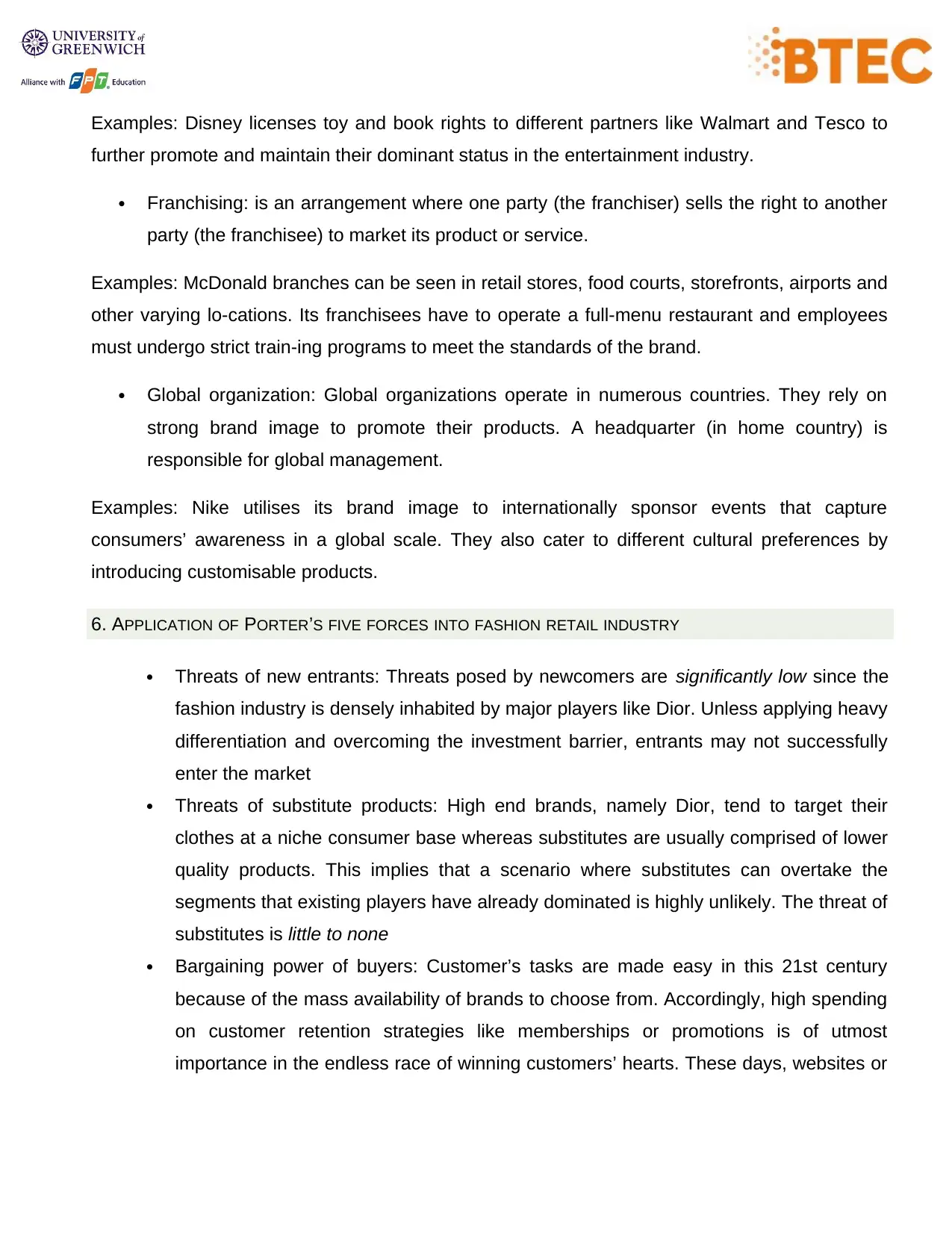
Examples: Disney licenses toy and book rights to different partners like Walmart and Tesco to
further promote and maintain their dominant status in the entertainment industry.
Franchising: is an arrangement where one party (the franchiser) sells the right to another
party (the franchisee) to market its product or service.
Examples: McDonald branches can be seen in retail stores, food courts, storefronts, airports and
other varying lo-cations. Its franchisees have to operate a full-menu restaurant and employees
must undergo strict train-ing programs to meet the standards of the brand.
Global organization: Global organizations operate in numerous countries. They rely on
strong brand image to promote their products. A headquarter (in home country) is
responsible for global management.
Examples: Nike utilises its brand image to internationally sponsor events that capture
consumers’ awareness in a global scale. They also cater to different cultural preferences by
introducing customisable products.
6. APPLICATION OF PORTER’S FIVE FORCES INTO FASHION RETAIL INDUSTRY
Threats of new entrants: Threats posed by newcomers are significantly low since the
fashion industry is densely inhabited by major players like Dior. Unless applying heavy
differentiation and overcoming the investment barrier, entrants may not successfully
enter the market
Threats of substitute products: High end brands, namely Dior, tend to target their
clothes at a niche consumer base whereas substitutes are usually comprised of lower
quality products. This implies that a scenario where substitutes can overtake the
segments that existing players have already dominated is highly unlikely. The threat of
substitutes is little to none
Bargaining power of buyers: Customer’s tasks are made easy in this 21st century
because of the mass availability of brands to choose from. Accordingly, high spending
on customer retention strategies like memberships or promotions is of utmost
importance in the endless race of winning customers’ hearts. These days, websites or
further promote and maintain their dominant status in the entertainment industry.
Franchising: is an arrangement where one party (the franchiser) sells the right to another
party (the franchisee) to market its product or service.
Examples: McDonald branches can be seen in retail stores, food courts, storefronts, airports and
other varying lo-cations. Its franchisees have to operate a full-menu restaurant and employees
must undergo strict train-ing programs to meet the standards of the brand.
Global organization: Global organizations operate in numerous countries. They rely on
strong brand image to promote their products. A headquarter (in home country) is
responsible for global management.
Examples: Nike utilises its brand image to internationally sponsor events that capture
consumers’ awareness in a global scale. They also cater to different cultural preferences by
introducing customisable products.
6. APPLICATION OF PORTER’S FIVE FORCES INTO FASHION RETAIL INDUSTRY
Threats of new entrants: Threats posed by newcomers are significantly low since the
fashion industry is densely inhabited by major players like Dior. Unless applying heavy
differentiation and overcoming the investment barrier, entrants may not successfully
enter the market
Threats of substitute products: High end brands, namely Dior, tend to target their
clothes at a niche consumer base whereas substitutes are usually comprised of lower
quality products. This implies that a scenario where substitutes can overtake the
segments that existing players have already dominated is highly unlikely. The threat of
substitutes is little to none
Bargaining power of buyers: Customer’s tasks are made easy in this 21st century
because of the mass availability of brands to choose from. Accordingly, high spending
on customer retention strategies like memberships or promotions is of utmost
importance in the endless race of winning customers’ hearts. These days, websites or
⊘ This is a preview!⊘
Do you want full access?
Subscribe today to unlock all pages.

Trusted by 1+ million students worldwide
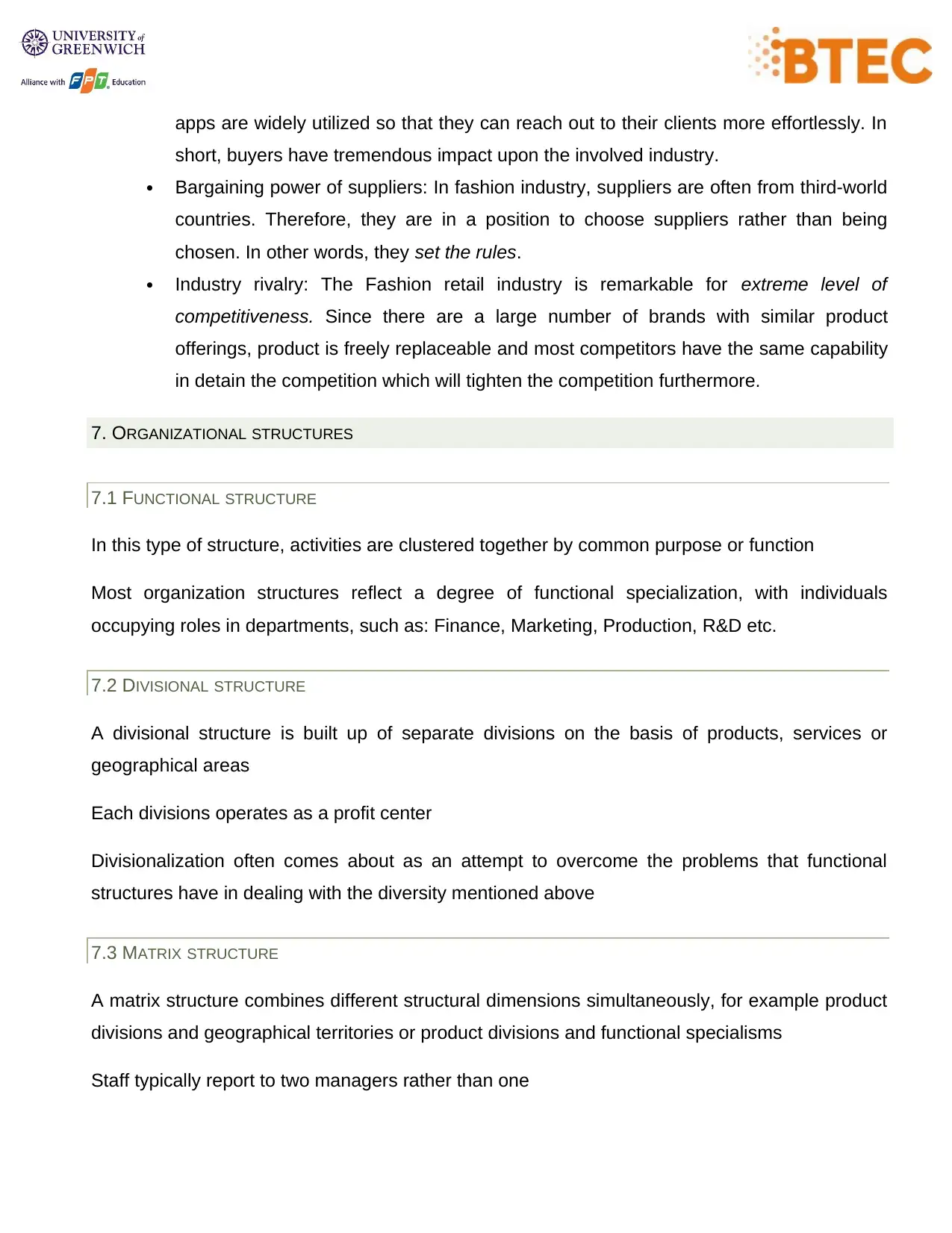
apps are widely utilized so that they can reach out to their clients more effortlessly. In
short, buyers have tremendous impact upon the involved industry.
Bargaining power of suppliers: In fashion industry, suppliers are often from third-world
countries. Therefore, they are in a position to choose suppliers rather than being
chosen. In other words, they set the rules.
Industry rivalry: The Fashion retail industry is remarkable for extreme level of
competitiveness. Since there are a large number of brands with similar product
offerings, product is freely replaceable and most competitors have the same capability
in detain the competition which will tighten the competition furthermore.
7. ORGANIZATIONAL STRUCTURES
7.1 FUNCTIONAL STRUCTURE
In this type of structure, activities are clustered together by common purpose or function
Most organization structures reflect a degree of functional specialization, with individuals
occupying roles in departments, such as: Finance, Marketing, Production, R&D etc.
7.2 DIVISIONAL STRUCTURE
A divisional structure is built up of separate divisions on the basis of products, services or
geographical areas
Each divisions operates as a profit center
Divisionalization often comes about as an attempt to overcome the problems that functional
structures have in dealing with the diversity mentioned above
7.3 MATRIX STRUCTURE
A matrix structure combines different structural dimensions simultaneously, for example product
divisions and geographical territories or product divisions and functional specialisms
Staff typically report to two managers rather than one
short, buyers have tremendous impact upon the involved industry.
Bargaining power of suppliers: In fashion industry, suppliers are often from third-world
countries. Therefore, they are in a position to choose suppliers rather than being
chosen. In other words, they set the rules.
Industry rivalry: The Fashion retail industry is remarkable for extreme level of
competitiveness. Since there are a large number of brands with similar product
offerings, product is freely replaceable and most competitors have the same capability
in detain the competition which will tighten the competition furthermore.
7. ORGANIZATIONAL STRUCTURES
7.1 FUNCTIONAL STRUCTURE
In this type of structure, activities are clustered together by common purpose or function
Most organization structures reflect a degree of functional specialization, with individuals
occupying roles in departments, such as: Finance, Marketing, Production, R&D etc.
7.2 DIVISIONAL STRUCTURE
A divisional structure is built up of separate divisions on the basis of products, services or
geographical areas
Each divisions operates as a profit center
Divisionalization often comes about as an attempt to overcome the problems that functional
structures have in dealing with the diversity mentioned above
7.3 MATRIX STRUCTURE
A matrix structure combines different structural dimensions simultaneously, for example product
divisions and geographical territories or product divisions and functional specialisms
Staff typically report to two managers rather than one
Paraphrase This Document
Need a fresh take? Get an instant paraphrase of this document with our AI Paraphraser
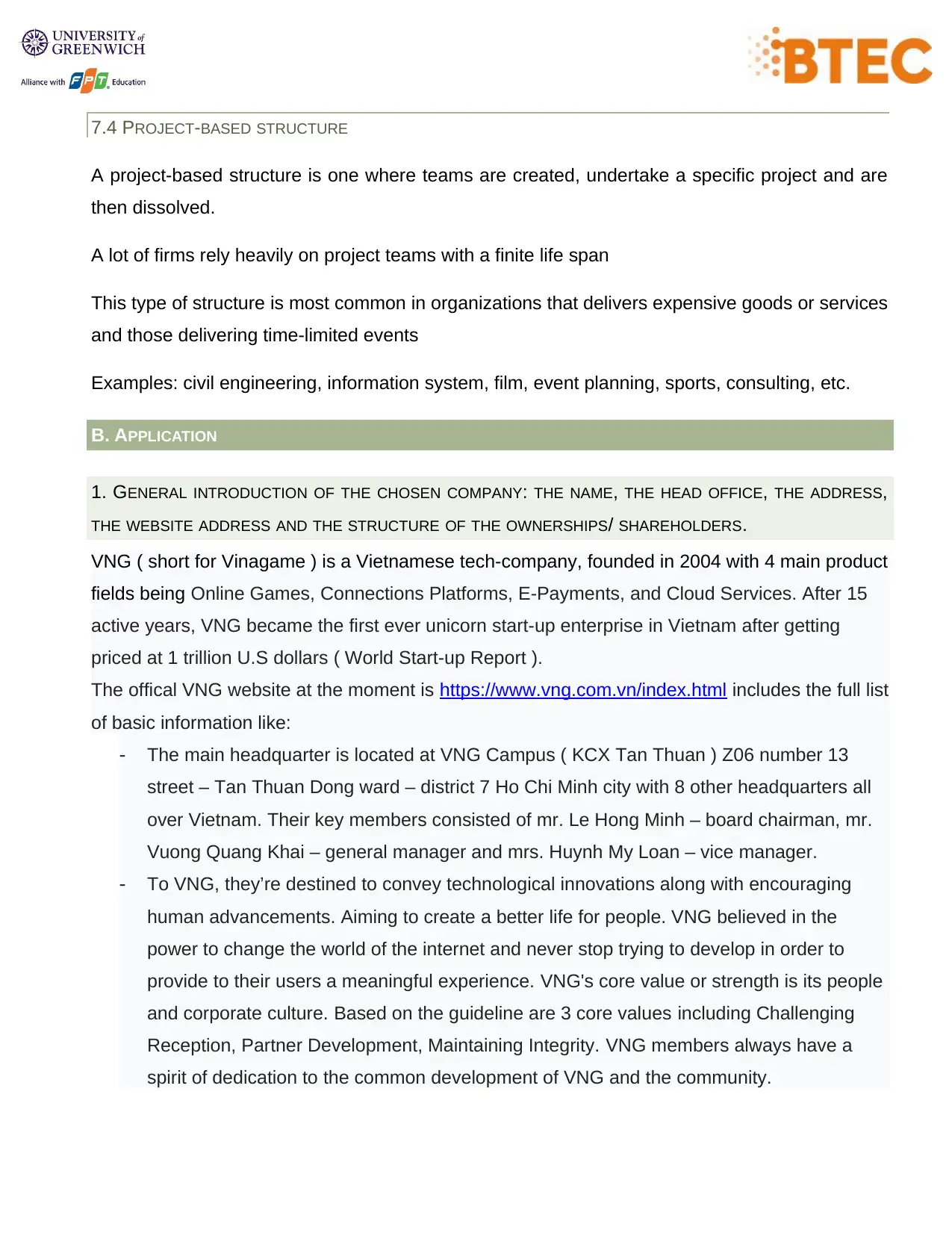
7.4 PROJECT-BASED STRUCTURE
A project-based structure is one where teams are created, undertake a specific project and are
then dissolved.
A lot of firms rely heavily on project teams with a finite life span
This type of structure is most common in organizations that delivers expensive goods or services
and those delivering time-limited events
Examples: civil engineering, information system, film, event planning, sports, consulting, etc.
B. APPLICATION
1. GENERAL INTRODUCTION OF THE CHOSEN COMPANY: THE NAME, THE HEAD OFFICE, THE ADDRESS,
THE WEBSITE ADDRESS AND THE STRUCTURE OF THE OWNERSHIPS/ SHAREHOLDERS.
VNG ( short for Vinagame ) is a Vietnamese tech-company, founded in 2004 with 4 main product
fields being Online Games, Connections Platforms, E-Payments, and Cloud Services. After 15
active years, VNG became the first ever unicorn start-up enterprise in Vietnam after getting
priced at 1 trillion U.S dollars ( World Start-up Report ).
The offical VNG website at the moment is https://www.vng.com.vn/index.html includes the full list
of basic information like:
- The main headquarter is located at VNG Campus ( KCX Tan Thuan ) Z06 number 13
street – Tan Thuan Dong ward – district 7 Ho Chi Minh city with 8 other headquarters all
over Vietnam. Their key members consisted of mr. Le Hong Minh – board chairman, mr.
Vuong Quang Khai – general manager and mrs. Huynh My Loan – vice manager.
- To VNG, they’re destined to convey technological innovations along with encouraging
human advancements. Aiming to create a better life for people. VNG believed in the
power to change the world of the internet and never stop trying to develop in order to
provide to their users a meaningful experience. VNG's core value or strength is its people
and corporate culture. Based on the guideline are 3 core values including Challenging
Reception, Partner Development, Maintaining Integrity. VNG members always have a
spirit of dedication to the common development of VNG and the community.
A project-based structure is one where teams are created, undertake a specific project and are
then dissolved.
A lot of firms rely heavily on project teams with a finite life span
This type of structure is most common in organizations that delivers expensive goods or services
and those delivering time-limited events
Examples: civil engineering, information system, film, event planning, sports, consulting, etc.
B. APPLICATION
1. GENERAL INTRODUCTION OF THE CHOSEN COMPANY: THE NAME, THE HEAD OFFICE, THE ADDRESS,
THE WEBSITE ADDRESS AND THE STRUCTURE OF THE OWNERSHIPS/ SHAREHOLDERS.
VNG ( short for Vinagame ) is a Vietnamese tech-company, founded in 2004 with 4 main product
fields being Online Games, Connections Platforms, E-Payments, and Cloud Services. After 15
active years, VNG became the first ever unicorn start-up enterprise in Vietnam after getting
priced at 1 trillion U.S dollars ( World Start-up Report ).
The offical VNG website at the moment is https://www.vng.com.vn/index.html includes the full list
of basic information like:
- The main headquarter is located at VNG Campus ( KCX Tan Thuan ) Z06 number 13
street – Tan Thuan Dong ward – district 7 Ho Chi Minh city with 8 other headquarters all
over Vietnam. Their key members consisted of mr. Le Hong Minh – board chairman, mr.
Vuong Quang Khai – general manager and mrs. Huynh My Loan – vice manager.
- To VNG, they’re destined to convey technological innovations along with encouraging
human advancements. Aiming to create a better life for people. VNG believed in the
power to change the world of the internet and never stop trying to develop in order to
provide to their users a meaningful experience. VNG's core value or strength is its people
and corporate culture. Based on the guideline are 3 core values including Challenging
Reception, Partner Development, Maintaining Integrity. VNG members always have a
spirit of dedication to the common development of VNG and the community.
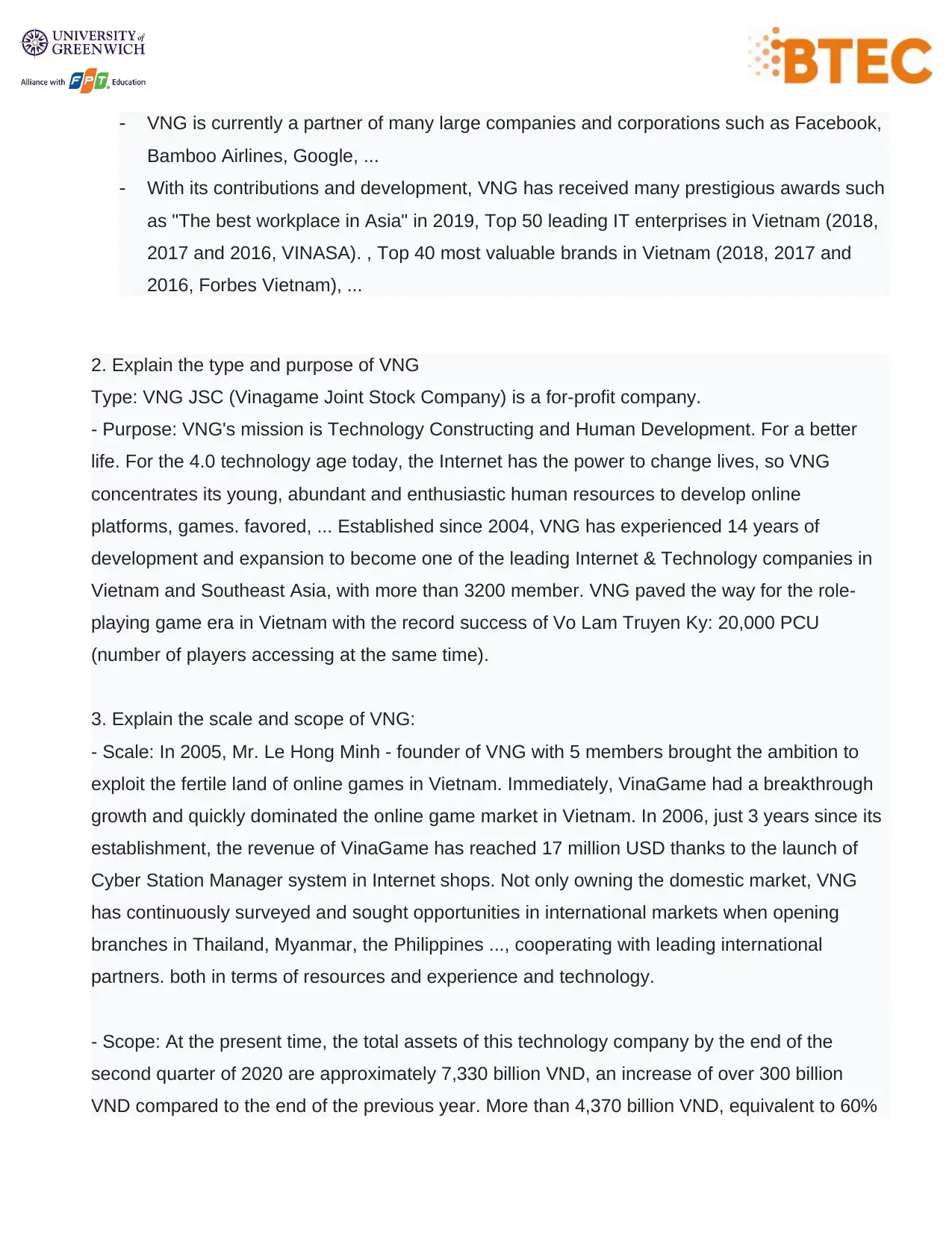
- VNG is currently a partner of many large companies and corporations such as Facebook,
Bamboo Airlines, Google, ...
- With its contributions and development, VNG has received many prestigious awards such
as "The best workplace in Asia" in 2019, Top 50 leading IT enterprises in Vietnam (2018,
2017 and 2016, VINASA). , Top 40 most valuable brands in Vietnam (2018, 2017 and
2016, Forbes Vietnam), ...
2. Explain the type and purpose of VNG
Type: VNG JSC (Vinagame Joint Stock Company) is a for-profit company.
- Purpose: VNG's mission is Technology Constructing and Human Development. For a better
life. For the 4.0 technology age today, the Internet has the power to change lives, so VNG
concentrates its young, abundant and enthusiastic human resources to develop online
platforms, games. favored, ... Established since 2004, VNG has experienced 14 years of
development and expansion to become one of the leading Internet & Technology companies in
Vietnam and Southeast Asia, with more than 3200 member. VNG paved the way for the role-
playing game era in Vietnam with the record success of Vo Lam Truyen Ky: 20,000 PCU
(number of players accessing at the same time).
3. Explain the scale and scope of VNG:
- Scale: In 2005, Mr. Le Hong Minh - founder of VNG with 5 members brought the ambition to
exploit the fertile land of online games in Vietnam. Immediately, VinaGame had a breakthrough
growth and quickly dominated the online game market in Vietnam. In 2006, just 3 years since its
establishment, the revenue of VinaGame has reached 17 million USD thanks to the launch of
Cyber Station Manager system in Internet shops. Not only owning the domestic market, VNG
has continuously surveyed and sought opportunities in international markets when opening
branches in Thailand, Myanmar, the Philippines ..., cooperating with leading international
partners. both in terms of resources and experience and technology.
- Scope: At the present time, the total assets of this technology company by the end of the
second quarter of 2020 are approximately 7,330 billion VND, an increase of over 300 billion
VND compared to the end of the previous year. More than 4,370 billion VND, equivalent to 60%
Bamboo Airlines, Google, ...
- With its contributions and development, VNG has received many prestigious awards such
as "The best workplace in Asia" in 2019, Top 50 leading IT enterprises in Vietnam (2018,
2017 and 2016, VINASA). , Top 40 most valuable brands in Vietnam (2018, 2017 and
2016, Forbes Vietnam), ...
2. Explain the type and purpose of VNG
Type: VNG JSC (Vinagame Joint Stock Company) is a for-profit company.
- Purpose: VNG's mission is Technology Constructing and Human Development. For a better
life. For the 4.0 technology age today, the Internet has the power to change lives, so VNG
concentrates its young, abundant and enthusiastic human resources to develop online
platforms, games. favored, ... Established since 2004, VNG has experienced 14 years of
development and expansion to become one of the leading Internet & Technology companies in
Vietnam and Southeast Asia, with more than 3200 member. VNG paved the way for the role-
playing game era in Vietnam with the record success of Vo Lam Truyen Ky: 20,000 PCU
(number of players accessing at the same time).
3. Explain the scale and scope of VNG:
- Scale: In 2005, Mr. Le Hong Minh - founder of VNG with 5 members brought the ambition to
exploit the fertile land of online games in Vietnam. Immediately, VinaGame had a breakthrough
growth and quickly dominated the online game market in Vietnam. In 2006, just 3 years since its
establishment, the revenue of VinaGame has reached 17 million USD thanks to the launch of
Cyber Station Manager system in Internet shops. Not only owning the domestic market, VNG
has continuously surveyed and sought opportunities in international markets when opening
branches in Thailand, Myanmar, the Philippines ..., cooperating with leading international
partners. both in terms of resources and experience and technology.
- Scope: At the present time, the total assets of this technology company by the end of the
second quarter of 2020 are approximately 7,330 billion VND, an increase of over 300 billion
VND compared to the end of the previous year. More than 4,370 billion VND, equivalent to 60%
⊘ This is a preview!⊘
Do you want full access?
Subscribe today to unlock all pages.

Trusted by 1+ million students worldwide
1 out of 14
Related Documents
Your All-in-One AI-Powered Toolkit for Academic Success.
+13062052269
info@desklib.com
Available 24*7 on WhatsApp / Email
![[object Object]](/_next/static/media/star-bottom.7253800d.svg)
Unlock your academic potential
Copyright © 2020–2025 A2Z Services. All Rights Reserved. Developed and managed by ZUCOL.





